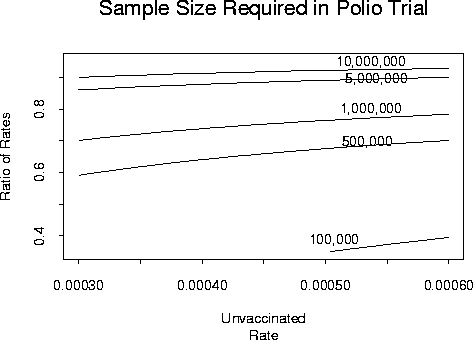STAT 330 Lecture 16
Reading for Today's Lecture: 8.1, 8.2, 8.3, 9.1, 9.2, 9.4: focus on power and sample size calculations.
Goals of Today's Lecture:
Today's notes
Sample Size Calculations
Set
![]()
and solve for n. You need to specify:
Our example had ![]() and
and ![]() .
So
.
So
![]()
which happens if
![]()
which we solve to get
![]()
or
![]()
In our example
|
| | |
|
| | |
|
| | |
so that
![]()
We round up to n=20 to get the type II error rate to be definitely under 10%.
CRITICISM: the catalyst may very well have changed ![]() and
and
![]() will normally be unknown.
will normally be unknown.
You would then use the equation
![]()
Notice that n shows up in two places in the formula.
Problem: Solution depends not on the alternative ![]() but really on
but really on
![]() and you need to specify a value for this quantity
which is harder to interpret than
and you need to specify a value for this quantity
which is harder to interpret than ![]() usually. You then look up
usually. You then look up
![]() versus n in the graph in Appendix A.13. The solution is generally
bigger than the formula above for the same value of d.
versus n in the graph in Appendix A.13. The solution is generally
bigger than the formula above for the same value of d.
A two sample example
![]()
![]()
(A calculation of this sort might have been made ahead of the 1954 Salk polio vaccine trials.)
WARNING: Polio is a contagious disease (though not terribly so) and so the independence between people is in grave doubt.
Sample size determination requires the following ingredients:
We take ![]() and
and ![]() and try various values of
and try various values of
![]() in the range of 30 to 50 per 100,000 and
in the range of 30 to 50 per 100,000 and ![]() in the range of
1 to 40 per 100,000 but in any case with
in the range of
1 to 40 per 100,000 but in any case with ![]() .
.
We use the usual test statistic with n=m, namely,

We make the approximation that the value of ![]() will be roughly
will be roughly
![]() and then compute
and then compute

So to find n set

and solve for n. This can be done. Here is a contour plot of the results. The contours
indicate combinations of ![]() and
and ![]() which require the sample size indicated
on the line. Notice that the sample sizes are VERY large.
which require the sample size indicated
on the line. Notice that the sample sizes are VERY large.
